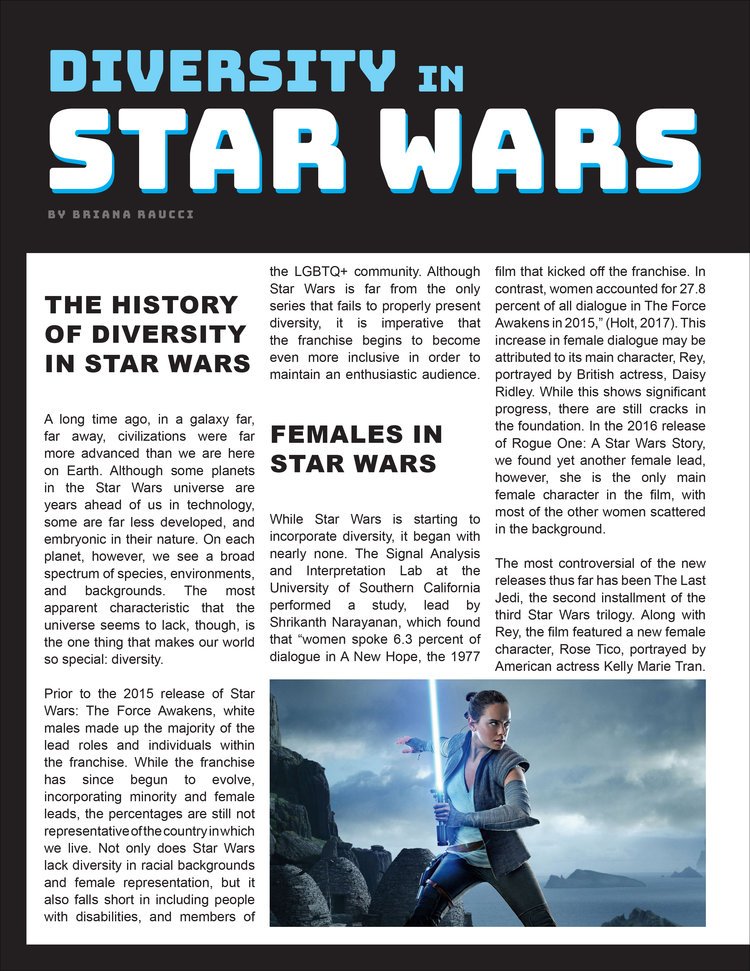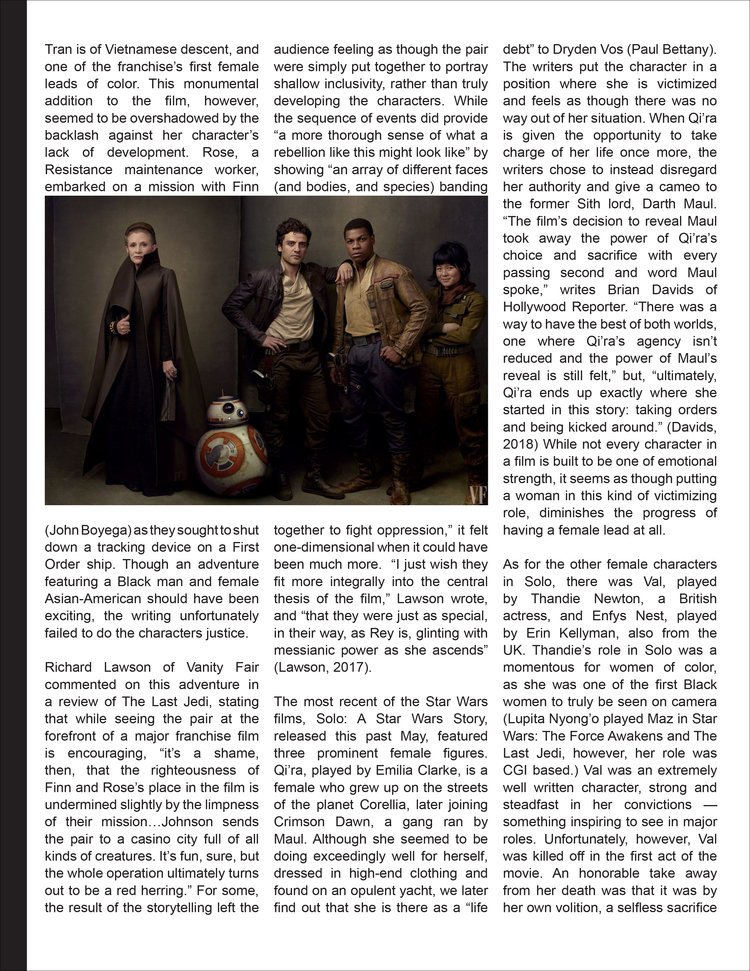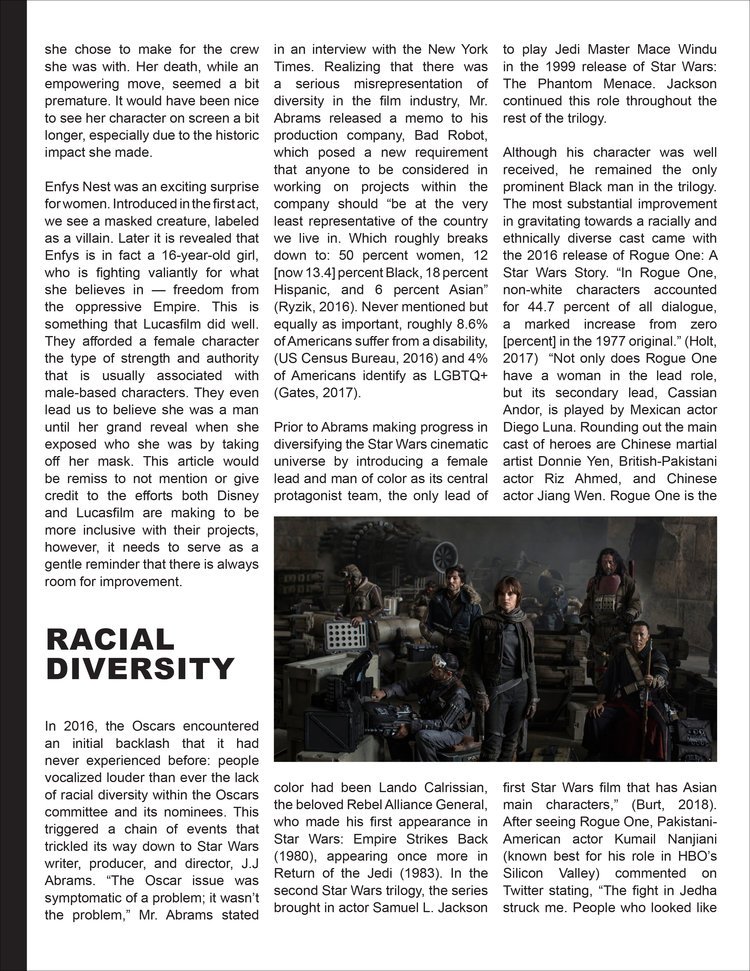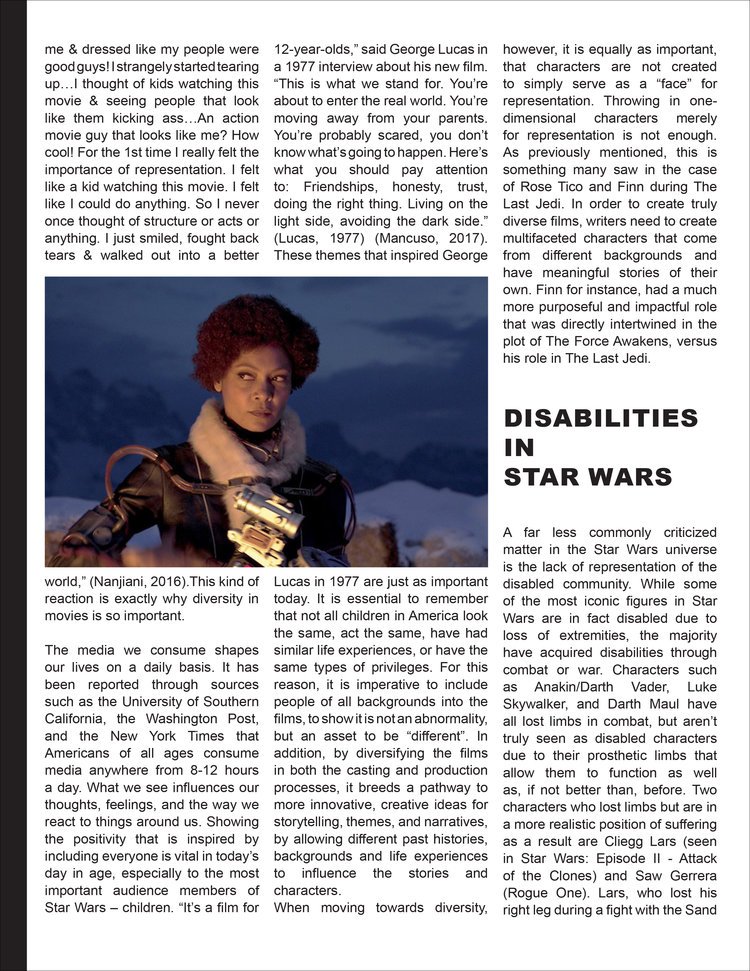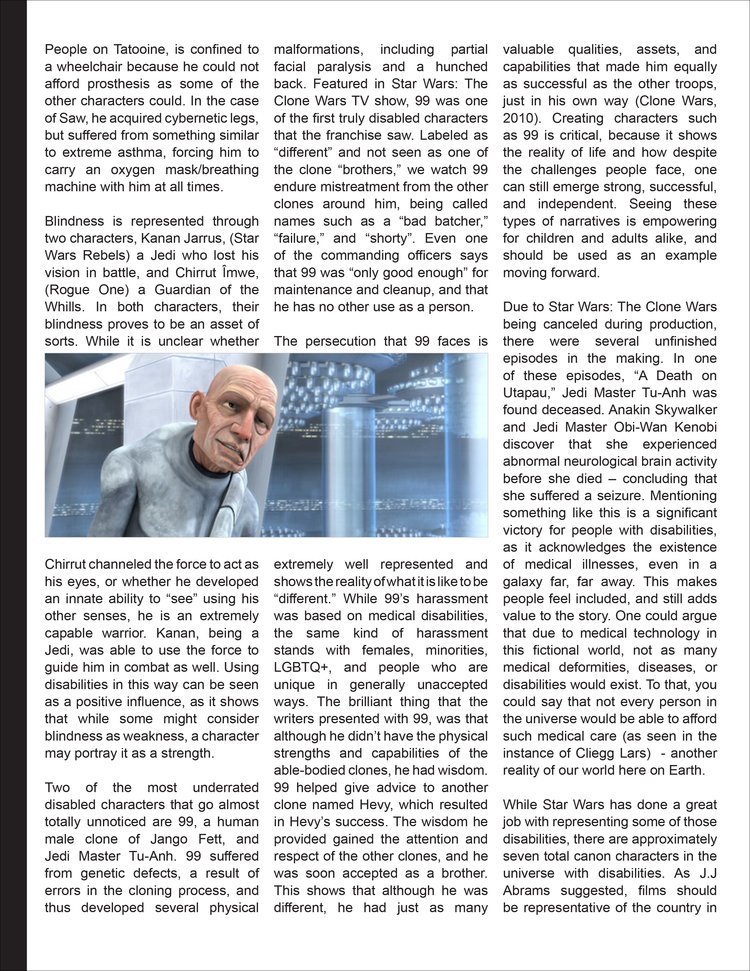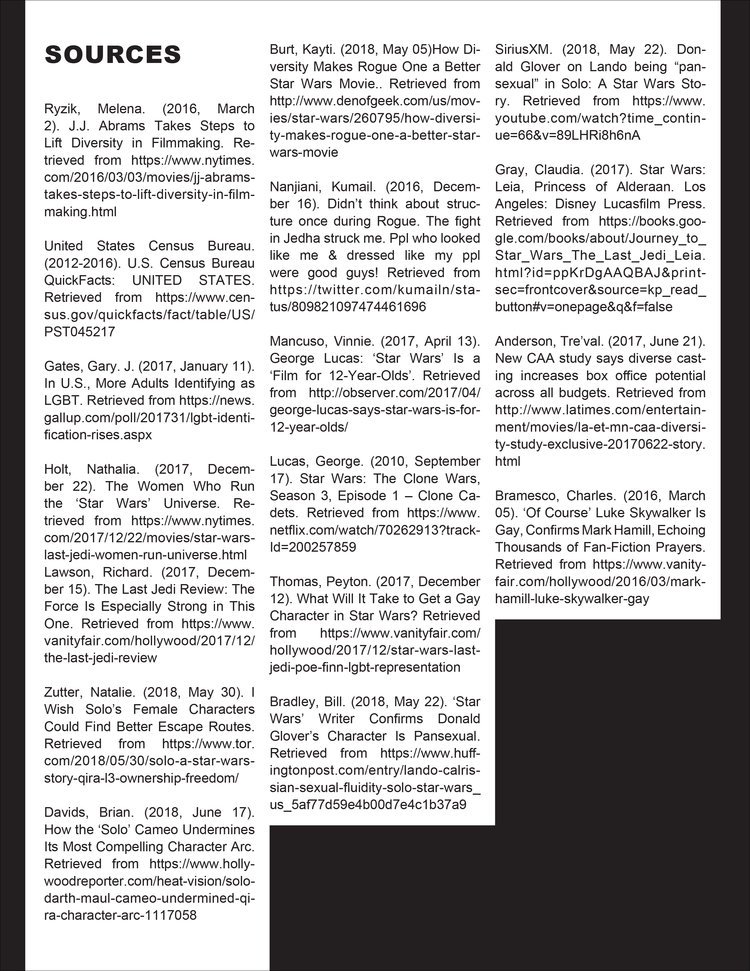Diversity in Star Wars
A long time ago, in a galaxy far, far away, civilizations were far more advanced than we are here on Earth. While some planets in the Star Wars universe are years ahead of us in technology, some are far less developed, and embryonic in their nature. On each planet, however, we see a broad spectrum of species, environments, and backgrounds. The most apparent characteristic that the universe seems to lack, though, is the one thing that makes our world so special: diversity.
Up until the 2015 release of Star Wars: The Force Awakens, white male characters made up the majority of the lead roles and individuals within the franchise. While the franchise is slowly starting to incorporate minority and female leads, the percentages are still not representative of the country in which we live. Not only does Star Wars lack diversity in racial backgrounds and female representation, but it also falls short in including people with disabilities, and members of the LGBTQ+ community. Although Star Wars is far from the only series that fails to properly present diversity, it is imperative that the franchise begins to become even more inclusive in order to maintain an enthusiastic audience.
*Update as of January 3, 2025, I have written an updated article specifically addressing Disabilities in Star Wars. In Skeleton Crew Episode 6, Zero Friends Again, KB’s character is a transformative moment for disability representation in Star Wars. KB’s story is not a subplot or a footnote—it is central to the episode’s narrative. After you finish this read, check out my article Disabilities in Star Wars: The Evolution of Representation and the Impact of KB in Skeleton Crew.
The History of Diversity in Star Wars
Female Representation
While Star Wars is starting to incorporate diversity, it began with nearly none. The Signal Analysis and Interpretation Lab at the University of Southern California performed a study, lead by Shrikanth Narayanan, which found that “women spoke 6.3 percent of dialogue in A New Hope, the 1977 film that kicked off the franchise. In contrast, women accounted for 27.8 percent of all dialogue in The Force Awakens in 2015,” (Holt, 2017). This increase in female dialogue may be attributed to its main character, Rey, portrayed by British actress, Daisy Ridley. While this shows significant progress, there are still cracks in the foundation. In the 2016 release of Rogue One: A Star Wars Story, we found yet another female lead, however, she is the only main female character in the film, with most of the other women scattered in the background.
The most controversial of the new releases thus far has been The Last Jedi, the second installment of the third Star Wars trilogy. Along with Rey, the film featured a new female character, Rose Tico, portrayed by American actress Kelly Marie Tran. Tran is of Vietnamese descent, and one of the franchise’s first female leads of color. This monumental addition to the film, however, seemed to be overshadowed by the backlash against her character’s lack of development. Rose, a Resistance maintenance worker, embarked on a mission with Finn (John Boyega) as they sought to shut down a tracking device on a First Order ship. Though an adventure featuring a Black man and female Asian-American should have been exciting, the writing unfortunately failed to do the characters justice.
Richard Lawson of Vanity Fair commented on this adventure in a review of The Last Jedi, stating that while seeing the pair at the forefront of a major franchise film is encouraging, “it’s a shame, then, that the righteousness of Finn and Rose’s place in the film is undermined slightly by the limpness of their mission…Johnson sends the pair to a casino city full of all kinds of creatures. It’s fun, sure, but the whole operation ultimately turns out to be a red herring.” For some, the result of the storytelling left the audience feeling as though the pair were simply put together to portray shallow inclusivity, rather than truly developing the characters. While the sequence of events did provide “a more thorough sense of what a rebellion like this might look like” by showing “an array of different faces (and bodies, and species) banding together to fight oppression,” it felt one-dimensional when it could have been much more. “I just wish they fit more integrally into the central thesis of the film,” Lawson wrote, and “that they were just as special, in their way, as Rey is, glinting with messianic power as she ascends” (Lawson, 2017).
The most recent of the Star Wars films, Solo: A Star Wars Story, released this past May, featured three prominent female figures. Qi’ra, played by Emilia Clarke, is a female who grew up on the streets of the planet Corellia, later joining Crimson Dawn, a gang ran by Maul. Although she seemed to be doing exceedingly well for herself, dressed in high-end clothing and found on an opulent yacht, we later find out that she is there as a “life debt” to Dryden Vos (Paul Bettany). The writers put the character in a position where she is victimized and feels as though there was no way out of her situation. When Qi’ra is given the opportunity to take charge of her life once more, the writers chose to instead disregard her authority and give a cameo to the former Sith lord, Darth Maul. “The film’s decision to reveal Maul took away the power of Qi’ra’s choice and sacrifice with every passing second and word Maul spoke,” writes Brian Davids of Hollywood Reporter. “There was a way to have the best of both worlds, one where Qi’ra’s agency isn’t reduced and the power of Maul’s reveal is still felt,” but, “ultimately, Qi’ra ends up exactly where she started in this story: taking orders and being kicked around.” (Davids, 2018) While not every character in a film is built to be one of emotional strength, it seems as though putting a woman in this kind of victimizing role, diminishes the progress of having a female lead at all.
As for the other female characters in Solo, there was Val, played by Thandie Newton, a British actress, and Enfys Nest, played by Erin Kellyman, also from the UK. Thandie’s role in Solo was a momentous for women of color, as she was one of the first Black women to truly be seen on camera (Lupita Nyong'o played Maz in Star Wars: The Force Awakens and The Last Jedi, however, her role was CGI based.) Val was an extremely well written character, strong and steadfast in her convictions — something inspiring to see in major roles. Unfortunately, however, Val was killed off in the first act of the movie. A positive take away from her death was that it was by her own volition, a sacrifice she chose to make for the crew she was with. Her death, while an empowering move, seemed a bit premature. It would have been nice to see her character on screen a bit longer, especially due to the historic impact she made.
Enfys Nest was an exciting surprise for women. Introduced in the first act, we see a masked creature, labeled as a villain. Later it is revealed that Enfys is in fact a 16-year-old girl, who is fighting valiantly for what she believes in — freedom from the oppressive Empire. This is something that Lucasfilm did well. They gave a female character the type of strength and authority that is usually associated with male-based characters. They even lead us to believe she was a man until her grand reveal when she exposed who she was by taking off her mask. This article would be remiss to not mention or give credit to the efforts both Disney and Lucasfilm are making to be more inclusive with their projects, however, it needs to serve as a gentle reminder that there is always room for improvement.
Racial Diversity
In 2016, the Oscars encountered a backlash that it had never experienced before: people vocalized louder than ever the lack of racial diversity within the Oscars committee and its nominees. This triggered a chain of events that trickled its way down to Star Wars writer, producer, and director, J.J Abrams. “The Oscar issue was symptomatic of a problem; it wasn’t the problem,” Mr. Abrams stated in an interview with the New York Times. Realizing that there was a serious misrepresentation of diversity in the film industry, Mr. Abrams released a memo to his production company, Bad Robot, which posed a new requirement that anyone to be considered in working on projects within the company should “be at the very least representative of the country we live in. Which roughly breaks down to: 50 percent women, 12 [now 13.4] percent Black, 18 percent Hispanic, and 6 percent Asian” (Ryzik, 2016). Never mentioned but equally as important, roughly 8.6% of Americans suffer from a disability, (US Census Bureau, 2016) and 4% of Americans identify as LGBTQ+ (Gates, 2017).
Prior to Abrams making progress in diversifying the Star Wars cinematic universe by introducing a female lead and man of color as its central protagonist team, the only lead of color had been Lando Calrissian, the beloved Rebel Alliance General, who made his first appearance in Star Wars: Empire Strikes Back (1980), appearing once more in Return of the Jedi (1983). In the second Star Wars trilogy, the series brought in actor Samuel L. Jackson to play Jedi Master Mace Windu in the 1999 release of Star Wars: The Phantom Menace. Jackson continued this role throughout the rest of the trilogy. Although his character was well received, he was still the only prominent Black man in the trilogy. The biggest improvement in a more racially and ethnically diverse cast came with the 2016 release of Rogue One: A Star Wars Story. “In Rogue One, non-white characters accounted for 44.7 percent of all dialogue, a marked increase from zero [percent] in the 1977 original.” (Holt, 2017) “Not only does Rogue One have a woman in the lead role, but its secondary lead, Cassian Andor, is played by Mexican actor Diego Luna. Rounding out the main cast of heroes are Chinese martial artist Donnie Yen, British-Pakistani actor Riz Ahmed, and Chinese actor Jiang Wen. Rogue One is the first Star Wars film that has Asian main characters,” (Burt, 2018).
After seeing Rogue One, Pakistani-American actor Kumail Nanjiani (known best for his role in HBO’s Silicon Valley) commented on Twitter stating, “The fight in Jedha struck me. People who looked like me & dressed like my people were good guys! I strangely started tearing up…I thought of kids watching this movie & seeing people that look like them kicking ass…An action movie guy that looks like me? How cool! For the 1st time I really felt the importance of representation. I felt like a kid watching this movie. I felt like I could do anything. So I never once thought of structure or acts or anything. I just smiled, fought back tears & walked out into a better world,” (Nanjiani, 2016).
This kind of reaction is exactly why diversity in movies is so important. The media we consume shapes our lives on a daily basis. It has been reported through sources such as the University of Southern California, the Washington Post, and the New York Times that Americans of all ages consume media anywhere from 8-12 hours a day. What we see influences our thoughts, feelings, and the way we react to things around us. Showing the positivity that is inspired by including everyone is vital in today’s day in age, especially to the most important audience members of Star Wars – children.
“It’s a film for 12-year-olds,” said George Lucas in a 1977 interview about his new film. “This is what we stand for. You’re about to enter the real world. You’re moving away from your parents. You’re probably scared, you don’t know what’s going to happen. Here’s what you should pay attention to: Friendships, honesty, trust, doing the right thing. Living on the light side, avoiding the dark side.” (Lucas, 1977) (Mancuso, 2017).
These themes that inspired George Lucas in 1977 are just as important today. It is essential to remember that not all children in America look the same, act the same, have had similar life experiences, or have the same types of privileges. For this reason, it is imperative to include people of all backgrounds into the films, to show it is not an abnormality, but an asset to be “different”. In addition, by diversifying the films in both the casting and production processes, it breeds a pathway to more innovative, creative ideas for storytelling, themes, and narratives, by allowing different past histories, backgrounds and life experiences to influence the stories and characters.
When moving towards diversity, however, it is equally as important, that characters are not created to simply serve as a “face” for representation. Throwing in one-dimensional characters merely for representation is not enough. As previously mentioned, this is something many saw in the case of Rose Tico and Finn during The Last Jedi. In order to create truly diverse films, writers need to create multifaceted characters that come from different backgrounds and have meaningful stories of their own. Finn for instance, had a much more purposeful and impactful role that was directly intertwined in the plot of The Force Awakens, versus his role in The Last Jedi.
Disabilities in Star Wars
A far less commonly criticized matter in the Star Wars universe is the lack of representation of the disabled community. While some of the most iconic figures in Star Wars are in fact disabled due to lost of extremities, the majority have acquired disabilities through combat or war. Characters such as Anakin/Darth Vader, Luke Skywalker, and Darth Maul have all lost limbs in combat, but aren’t truly seen as disabled characters due to their prosthetic limbs that allow them to function as well as, if not better than, before. Two characters who limbs but are in a more realistic position of suffering as a result are Cliegg Lars (seen in Star Wars: Episode II - Attack of the Clones) and Saw Gerrera (Rogue One). Lars, who lost his right leg during a fight with the Sand People on Tatooine, is confined to a wheelchair because he could not afford prosthesis as some of the other characters could. In the case of Saw, he acquired cybernetic legs, but suffered from something similar to extreme asthma, forcing him to carry an oxygen mask/breathing machine with him at all times.
Blindness is represented through two characters, Kanan Jarrus, (Star Wars Rebels) a Jedi who lost his vision in battle, and Chirrut Îmwe, (Rogue One) a Guardian of the Whills. In both characters, their blindness proves to be an asset of sorts. While it is unclear whether Chirrut channeled the force to act as his eyes, or whether he developed an innate ability to “see” using his other senses, he is an extremely capable warrior. Kanan, being a Jedi, was able to use the force to guide him in combat as well. Using disabilities in this way can be seen as a positive influence, as it shows that while some might consider blindness as weakness, a character may portray it as a strength.
Two of the most underrated disabled characters that go almost totally unnoticed are 99, a human male clone of Jango Fett, and Jedi Master Tu-Anh. 99 suffered from genetic defects, a result of errors in the cloning process, and thus developed several physical malformations, including partial facial paralysis and a hunched back. Featured in Star Wars: The Clone Wars TV show, 99 was one of the first truly disabled characters that the franchise saw. Labeled as “different” and not seen as one of the clone “brothers,” we watch 99 endure mistreatment from the other clones around him, being called names such as a “bad batcher,” “failure,” and “shorty”. Even one of the commanding officers says that 99 was “only good enough” for maintenance and cleanup, and that he has no other use as a person.
The persecution that 99 faces is extremely well represented and shows the reality of what it is like to be “different.” While 99’s harassment was based on medical disabilities, the same kind of harassment stands with females, minorities, LGBTQ+, and people who are unique in generally unaccepted ways. The brilliant thing that the writers presented with 99, was that although he didn’t have the physical strengths and capabilities of the able-bodied clones, he had wisdom. 99 helped give advice to another clone named Hevy, which resulted in Hevy’s success. The wisdom he provided gained the attention and respect of the other clones, and he was soon accepted as a brother. This shows that although he was different, he had just as many valuable qualities, assets, and capabilities that made him equally as successful as the other troops, just in his own way (Clone Wars, 2010). Creating characters such as 99 is critical, because it shows the reality of life and how despite the challenges people face, one can still emerge strong, successful, and independent. Seeing these types of narratives is empowering for children and adults alike, and should be used as an example moving forward.
Due to Star Wars: The Clone Wars being canceled during production, there were several unfinished episodes in the making. In one of these episodes, “A Death on Utapau,” Jedi Master Tu-Anh was found deceased. Anakin Skywalker and Jedi Master Obi-Wan Kenobi discover that she experienced abnormal neurological brain activity before she died – concluding that she suffered a seizure. Mentioning something like this is a significant victory for people with disabilities, as it acknowledges the existence of medical illnesses, even in a galaxy far, far away. This makes people feel included, and still adds value to the story. One could argue that due to medical technology in this fictional world, not as many medical deformities, diseases, or disabilities would exist. To that, you could say that not every person in the universe would be able to afford such medical care (as seen in the instance of Cliegg Lars) - another reality of our world here on Earth.
While Star Wars has done a great job with representing some of those disabilities, there are approximately seven total canon characters in the universe with disabilities. As J.J Abrams suggested, films should be representative of the country in which we live, and right now, the numbers aren’t matching up. In addition, the disabilities that were best executed were not shown in the films, but in the TV shows, some of which did not even air. There is room to show how differences can be assets in the Star Wars films, and the writers should work towards making this a goal.
* Update* as of January 3rd, 2025, I have written a new article about disabilities in Star Wars. Focusing on KB from Star Wars Skeleton Crew, I address The Evolution of Representation (in Star Wars) and the Impact of KB in Skeleton Crew Episode 6: Zero Friends Again. Read Disabilities in Star Wars: The Evolution of Representation and the Impact of KB in Skeleton Crew.
LGBTQ+ In Star Wars
Currently, only two characters in the Star Wars canon franchise are known to be a part of the LGBTQ+ community - Lando Calrissian, (played by Billy Dee Williams in the original trilogy, and Donald Glover in Solo), as well as Admiral Amilyn Holdo, played by Laura Dern in The Last Jedi. As for Calrissian, father and son writing duo Jonathan and Lawrence Kasdan recently confirmed that the illustrious Lando Calrissian is indeed pansexual. In an interview with the Huffington Post, Bill Bradley asked if Lando’s sexuality could be fluid. “I would say yes,” Jonathan Kasdan emphatically said. “There’s a fluidity to Donald and Billy Dee’s [portrayal of Lando’s] sexuality,” Kasdan continued. “I mean, I would have loved to have gotten a more explicitly LGBT character into this movie. I think it’s time, certainly, for that, and I love the fluidity ― sort of the spectrum of sexuality that Donald appeals to and that droids are a part of,” said Kasdan. (Bradley, 2018)
When asked to comment on the confirmed pansexuality of his character, actor Donald Glover said, “How can you not be pansexual in space?” Glover said. “There’s so many things to have sex with. I didn’t think that was that weird. He’s coming on to everybody. It just didn’t seem that weird to me because I feel like if you’re in space, it’s kind of like the door’s open ... this thing is literally a blob. Like, ‘Are you a man or a woman?’ Who cares?” (SiriusXM, 2018) While his sexuality was well received by the actor, many fans backlashed at the idea of Lando not being a straight man. This criticism seems to be a common theme whenever a character of color, a woman in a lead position, or an LGBTQ+ character is introduced. The resistance to change and progress comes as no surprise given that it is a common issue in the world as a whole today, let alone in the film industry; however, it is discouraging for filmmakers and the actors themselves when they are harassed for representing these changes.
Although it has been stated that there is a push to include more LGBTQ+ characters in the universe, it has yet to become apparent. The only other instance of LGBTQ+ representation is in the 2017 novel Star Wars: Leia, Princess of Alderaan. Author Claudia Gray alluded to Amilyn Holdo being queer, though that is a little known fact for those who do not look beyond the films.
The biggest Star Wars star of them all, Mark Hamill himself, has shown his admiration and respect for the LGBTQ+ community, once stating that, “...fans are writing and ask all these questions, 'I'm bullied in school... I'm afraid to come out'. They say to me, 'Could Luke be gay?' I'd say it is meant to be interpreted by the viewer... If you think Luke is gay, of course he is. You should not be ashamed of it. Judge Luke by his character, not by who he loves,” (Bramesco, 2016). This kind of support helps the fans, and hopefully, will influence the decision makers of the franchise as well.
President of Lucasfilm, Kathleen Kennedy stated in a 2013 interview with USA Today that, “The demographics within our business don’t reflect society, and they certainly don’t reflect the audience. There should be many, many more faces of color, many more women, many more gay people,” (Peyton, 2017). When Kennedy became President of Lucasfilm in 2012, she founded the Star Wars story group, putting former film and TV writer Kiri Hart in charge of the unit. “Ms. Hart’s first move was to make the story group entirely female…their other qualification: a shared love of Star Wars.” Ms. Hart is now the senior vice president of development at Lucasfilm, and the story group continues to work on creating more diverse characters. In addition, the story group has since evolved, diversifying itself, and is now comprised of five people of color, four women and seven men. (Holt, 2017)
The Infamous Checklist
While diversity and inclusivity is extraordinarily important, it is also vital that it happens organically. When attempting diversification, it has been realized that some companies, organizations, and groups end up falling for “the quota.” Diversity can easily turn into a checklist, rather than a factor that allows creativity to flourish and develop into more realistic, engaging and truly rich stories. When the checkbox is used to write new material, the quality of the narrative drops significantly, and can actually become offensive. The characters turn into “one-dimensional, blink-and-you’ll-miss-’em characters that generally are given only a few seconds of screen time,” (Peyton, 2017).
So how do you create films, novels, games, and comics that are genuinely diverse and inclusive? Writing characters with varied backgrounds seems like the obvious answer, however, the issue stems back further in the process. The life that needs to be breathed into the franchise will come from hiring a diverse group of people to work together to create the stories. While the exact translation of the quote remains debatable, and the source itself has become a paradox, it has been reported by Plato that the great Greek philosopher Socrates once said something to the effect that, “what I do not know I do not think I know either,” which means that you don’t know what you don’t know. If you haven’t had certain experiences in life, you might not know those experiences even exist. Yes, most of us can imagine a lot of things, but not everything. Bringing in a group of people who have had truly different and varied life experiences based on their backgrounds, will be the defining factor in creating rich and immersive stories. The differences in people's understanding of life is what, when collaborating with one another, will deliver the kind of diversity that fans are looking for.
Just because women do not play as big of a role in Star Wars as men, does not mean that it should turn into all women either. A story group made up of only women might not understand the trials and tribulations that men have to deal with. In The Last Jedi, it almost seems as though the male characters were made to be more brash and foolish in order to emphasis the intelligence and strength of the women. Things like this are counter productive, as it is unnecessary to put one down to show the strengths of another. While these might seem like intimidating characteristics to achieve, they would come naturally with diverse story groups, producers, filmmakers, and directors – without such, it again, becomes a disingenuous checklist and quota.
Monetary Inspiration
With the extreme criticism of newer, more diverse characters, it becomes intimidating for writers, producers, directors, and actors to want to partake in becoming more diverse, however, newer studies actually show that it is in their best interest – financially. Of course, while the moral implications of diversity are the goal, money is what always does the talking. If money is what will help move the franchise towards genuine inclusively and richer storytelling, the Creative Artists Agency has proved through a study and database “that across every budget level a film with a diverse cast outperforms a release not so diversified.” (Anderson, 2018)
The contraction to this is that in some countries, such as China, diversity and showing characters that are LGBTQ+ are not acceptable and often censored. However, “In 2015, China accounted for just six percent of The Force Awakens’ global gross. Had the film never opened in China, it still would have earned $2 billion—a total surpassed only by Avatar and Titanic,” (Payton, 2017) so this does not appear to be a good reason not to take the step towards diversification.
Diversifying the Industry
This article does not claim to have gotten everything right. Points might have been missed, subjects may not have been touched upon as thoroughly as they could’ve been, but it is to serve as a reminder that progress is imperative, attempts and steps taken towards inclusivity and diversity should be recognized, and efforts in doing such should be encouraged to inspire more change and further benefit all people. Change never has, and never will occur without vocalization of the issues. Although no one person, company, organization, or group will ever be perfect and get it all right, it is still important to do the best conceivable job possible, to make sure everyone knows the value they hold, and can be inspired and empowered to make those positive changes themselves.
These changes do not just apply to the Star Wars franchise by any means – it is important to recognize and appreciate the advancements the franchise has made since it’s early beginnings; but to also support and have faith that they will be able to successfully accomplish the implementation of more diverse and inclusive stories and characters. Hopefully, these changes will inspire others and promote growth not only in the film industry, but also in the world as a whole - serving as a highly regarded example for progress. It is key to remember that change does not happen overnight as well; it will continue to be a growing process for the franchise, as long as Star Wars shall live. Where it goes will be a surprise to be sure, but a welcome one.
Sources:
Ryzik, Melena. (2016, March 2). J.J. Abrams Takes Steps to Lift Diversity in Filmmaking. Retrieved from https://www.nytimes.com/2016/03/03/movies/jj-abrams-takes-steps-to-lift-diversity-in-filmmaking.html
United States Census Bureau. (2012-2016). U.S. Census Bureau QuickFacts: UNITED STATES. Retrieved from https://www.census.gov/quickfacts/fact/table/US/PST045217
Gates, Gary. J. (2017, January 11). In U.S., More Adults Identifying as LGBT. Retrieved from https://news.gallup.com/poll/201731/lgbt-identification-rises.aspx
Holt, Nathalia. (2017, December 22). The Women Who Run the 'Star Wars' Universe. Retrieved from https://www.nytimes.com/2017/12/22/movies/star-wars-last-jedi-women-run-universe.html
Lawson, Richard. (2017, December 15). The Last Jedi Review: The Force Is Especially Strong in This One. Retrieved from https://www.vanityfair.com/hollywood/2017/12/the-last-jedi-review
Zutter, Natalie. (2018, May 30). I Wish Solo's Female Characters Could Find Better Escape Routes. Retrieved from https://www.tor.com/2018/05/30/solo-a-star-wars-story-qira-l3-ownership-freedom/
Davids, Brian. (2018, June 17). How the 'Solo' Cameo Undermines Its Most Compelling Character Arc. Retrieved from https://www.hollywoodreporter.com/heat-vision/solo-darth-maul-cameo-undermined-qi-ra-character-arc-1117058
Burt, Kayti. (2018, May 05)How Diversity Makes Rogue One a Better Star Wars Movie.. Retrieved from http://www.denofgeek.com/us/movies/star-wars/260795/how-diversity-makes-rogue-one-a-better-star-wars-movie
Nanjiani, Kumail. (2016, December 16). Didn't think about structure once during Rogue. The fight in Jedha struck me. Ppl who looked like me & dressed like my ppl were good guys! Retrieved from https://twitter.com/kumailn/status/809821097474461696
Mancuso, Vinnie. (2017, April 13). George Lucas: 'Star Wars' Is a 'Film for 12-Year-Olds'. Retrieved from http://observer.com/2017/04/george-lucas-says-star-wars-is-for-12-year-olds/
Lucas, George. (2010, September 17). Star Wars: The Clone Wars, Season 3, Episode 1 – Clone Cadets. Retrieved from https://www.netflix.com/watch/70262913?trackId=200257859
Thomas, Peyton. (2017, December 12). What Will It Take to Get a Gay Character in Star Wars? Retrieved from https://www.vanityfair.com/hollywood/2017/12/star-wars-last-jedi-poe-finn-lgbt-representation
Bradley, Bill. (2018, May 22). 'Star Wars' Writer Confirms Donald Glover's Character Is Pansexual. Retrieved from https://www.huffingtonpost.com/entry/lando-calrissian-sexual-fluidity-solo-star-wars_us_5af77d59e4b00d7e4c1b37a9
SiriusXM. (2018, May 22). Donald Glover on Lando being "pansexual" in Solo: A Star Wars Story. Retrieved from https://www.youtube.com/watch?time_continue=66&v=89LHRi8h6nA
Gray, Claudia. (2017). Star Wars: Leia, Princess of Alderaan. Los Angeles: Disney Lucasfilm Press. Retrieved from https://books.google.com/books/about/Journey_to_Star_Wars_The_Last_Jedi_Leia.html?id=ppKrDgAAQBAJ&printsec=frontcover&source=kp_read_button#v=onepage&q&f=false
Anderson, Tre’val. (2017, June 21). New CAA study says diverse casting increases box office potential across all budgets. Retrieved from http://www.latimes.com/entertainment/movies/la-et-mn-caa-diversity-study-exclusive-20170622-story.html
Bramesco, Charles. (2016, March 05). 'Of Course' Luke Skywalker Is Gay, Confirms Mark Hamill, Echoing Thousands of Fan-Fiction Prayers. Retrieved from https://www.vanityfair.com/hollywood/2016/03/mark-hamill-luke-skywalker-gay
